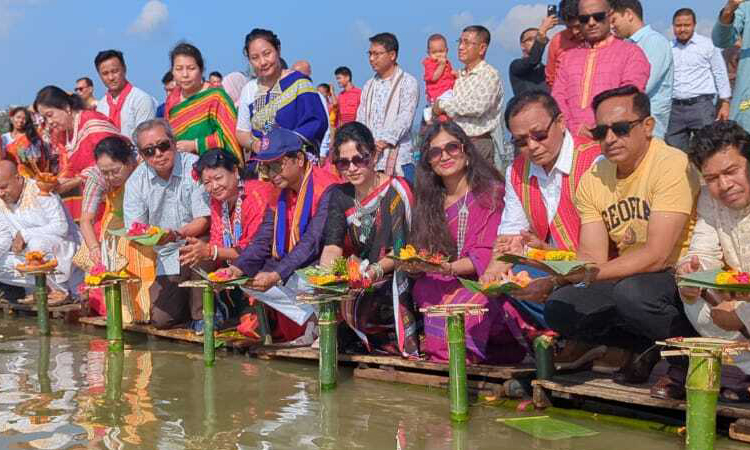News Flash
News Flash

RANGAMATI, April 12, 2025 (BSS) - Baisabi festival, the largest religious and social celebration of the indigenous communities in the hills, began today with offering flowers in Kaptai Lake.
The entire hill region wore a festive look marking the Baisabi festival. Colourful arrangements for Baisabi are going on in every remote area of the hills of the district and upazila including Rajbanvihar, Garjantali Tripura area of Rangamati, Kerani Pahar and other places.
Rangamati Hill District Council Chairman Kajal Talukder, Deputy Commissioner Mohammad Habib Ullah, Chief Executive Officer of District Council Khandaker Mohammad Rizaul Karim, Additional Deputy Commissioner (General) Mohammad Ruhul Amin, District Council Member Sagarika Roaja and Tripura Kalyan Foundation President Bidyut Tripura were present at the Baisabi festival in Rangamati Gorjantali Tripura area at the initiative of Tripura Kalyan Foundation this morning.
The Tripura community presented a variety of traditional and cultural programs, beginning with the symbolic floating of flowers in Kaptai Lake. Elderly members of the community were ceremonially bathed as part of the celebration.
Meanwhile, the Chakma community also marked the day with similar traditions in the Rajbanvihar area, including flower offerings in the lake. The event was attended by Ushatan Talukdar, vice-president of the Parbatya Chittagong Jana Sanghati Samiti and former Member of Parliament.
Baisabi is called 'Bijhu' in the Chakma language, 'Boisuk' in the Tripura language, 'Shangrai' in the Marma language, 'Bisu' in the Tangchangya language and 'Bihu' in the Ahmia language.
Today, on the first day of the festival, after floating flowers in Kaptai Lake, everyone will go home and decorate their houses with flowers and neem leaves, setting a festive and fragrant tone.
The atmosphere of Baisabi in the mountains, the first day of this three-day festival is called 'Phul Biju or Phul Biju' by the Chakmas, the second day 'Mool Biju' and the third day 'Nuabjhar or Gojya Pojya' by the Tripura people. And the first day is known as Harikuisuk, the second day is known as Buisukma and the third day is known as Bisikatal.
Basically, the Chakmas call it Biju, the Tripuras call it Baisuk, the Marmas call it 'Shangrai, the Tangchangyas call it Bisu, and the Ahmias call it Bihu. However, the Paharis call this festival Baisabi by combining the initials of the festival names of the three ethnic groups
Tripura, Marma, and Chakma, and it is called Baisabiin along with Nababarsh.
The Chakmas celebrate the first day of their festival as 'Phul Biju.' On this day, they pick Biju flowers and decorate their homes. In the evening, the flowers are floated down the river as part of the ritual. During the Biju festivities, young boys and girls dress in clean clothes and visit homes in groups. They greet the elders respectfully and sprinkle rice on the poultry as a gesture of goodwill and blessings.
At this time, delicious 'Pajon' is cooked in every house. This is a famous dish of the Chakmas. It is cooked with various vegetables. This is the favorite food of everyone during this festival. Boys and girls play Ghila Khel, Gudu (Ha Doo Doo). They light sky lamps and burst firecrackers to celebrate.
On New Year's Day, a variety of special dishes are prepared, as it's believed that enjoying good food on this day can bring the promise of delicious meals throughout the year.
Baisuk: The most fascinating festival among the religious and social celebrations of Tripura is Buysuk, also known as Baisuk. It is celebrated over the last two days of Chaitra and the first day of the New Year. The first of these two days, which marks the end of Chaitra, is referred to as 'Hari Buysuk' by the people of Tripura, while the last day is called 'Buysukma.' The first day of the New Year is celebrated as 'Bisikatal.'
On the first day of the festival, Tripura boys and girls pick flowers. Decorate their houses with flowers. Wash and clean their clothes.
Boys and girls wear clean clothes and roam around the village. They are served various pithas and the elders are given their traditional drinks. From the beginning of Baisuk, the 'Garaiya Dance Team' performs dances in the courtyards of every house in the village.
The atmosphere of Baisabi is felt in every house courtyard. After the 'Garaiya Dance', the artists are given chickens, rice, etc. After receiving these, the dancers bless the household. After the dance, the artists worship the Gariya deity with the items they received as gifts. From 16 to a maximum of 500 people can participate in this folk dance. Hundreds of cultural workers and artists from all over the country flock to the Chittagong Hill Tracts to watch this dance.
Sangrai: The letter 'Sa' of the Baisabi festival is taken from the 'Sangrai' festival of the Marmas, one of the smallest ethnic groups. Sangrai is one of the social festivals of the Marmas. This festival is celebrated on the last two days of the year and the first day of the New Year. During the celebration of the Sangrai festival, the Marmas youth prepare rice powder to make pitha. During this time, 'water play or water games' are held. The Sangrai festival and water games have now become synonymous with each other. In this game, young men and women throw water at each other. They wet each other. In addition, the Marmas go to Buddhist temples and listen to religious messages. This festival is held
on the occasion of Chaitra Sankranti. That is why the word Sangrai is believed to have come from the word Sankranti.
The colorful Baisabi festival will conclude in the hills with the Marmas' water games festival in Rangamati from April 16-19.
The Chakma, Marma, Tripura and other communities are celebrating the Baisabi festival with great joy. While the three-day festivities officially began on April 12, the vibrant celebrations continue throughout the month of April. With participation from all the hill Bengali communities, Baisabi becomes a powerful symbol of unity and togetherness.